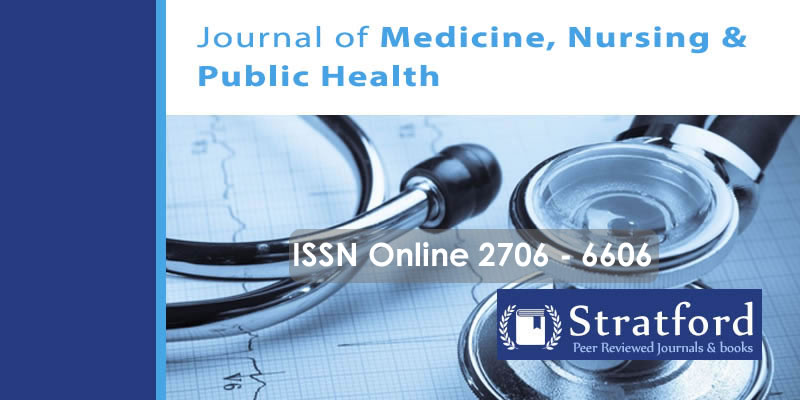Immunization Coverage among Children Aged Between 12-23 Months in West Pokot County, Kenya
DOI:
https://doi.org/10.53819/81018102t6047Abstract
Vaccination has been shown to be one of the most cost-effective health interventions worldwide. Despite the efforts made towards global immunization coverage, the number of unvaccinated and under-vaccinated infants is still high. The situation is no different in Kenya. Basic vaccination coverage reduced from 77% in 2008 to 70% in 2017. National basic vaccination coverage of 70% is significantly lower than the global target of 90% by the year 2020. There are gaping regional differences in immunization coverage. The lowest national immunization coverage is documented at 31% in West Pokot County. This study sought to identify the determinants of vaccination coverage among children between 12-23 months of age in West Pokot County. The study used a community-based cross-sectional design where mothers/guardians of children between 12-23 months old were randomly sampled. The objectives of the study were to estimate the immunization coverage, investigate factors influencing immunization coverage and determine the influence of health service utilization on immunization coverage. Binary logistic regression was conducted to determine the influence of the independent variables on the dependent variable. The findings showed that, majority (62.4%) of the mothers/guardians had partially immunized their children, followed by those who had fully immunized their children (36.6%) and lastly 1.1% had not immunized their children. Age of the mother/guardian is significantly associated with immunization coverage (OR = 1.128, p =0.000<0.05). This suggests that the older the mother/guardian, the higher the chances of the child being fully immunized. The distance to nearest health facility was found to have no significant relationship with immunization coverage (p>0.05). Respondents who paid for the services were more likely to have their children fully immunized than those who did not pay for the services (OR = 3.546, p =0.019<0.05). It was also observed that Paternal occupation influences coverage OR = 2.006, P =0.035<0.05), visiting the health facility in last year also influenced immunization (OR = 3.147, P =0.01<0.05). The study concluded that the immunization coverage among children between 12-23 months in West Pokot County is below the set target. It is therefore recommended that the county government should intensify vaccination campaigns and develop policies aimed at economically empowering the residents of West Pokot County.
Keywords: Immunization coverage, children aged between 12-23 months, West Pokot County
References
Chard, A. N., Gacic-Dobo, M., Diallo, M. S., Sodha, S. V., & Wallace, A. S. (2020). Routine Vaccination Coverage — Worldwide, 2019. MMWR Surveillance Summaries, 69(45), 1706–1710. https://doi.org/10.15585/mmwr.mm6945a7
Galadima, A. N., Zulkefli, N. A. M., Said, S. M., & Ahmad, N. (2021). Factors influencing childhood immunisation uptake in Africa: a systematic review. BMC Public Health, 21(1), 1–20. https://doi.org/10.1186/s12889-021-11466-5
Gavi Alliance. (2018). Gavi country factsheet: Kenya. https://www.gavi.org/country/kenya/
Girmay, A., & Dadi, A. F. (2019). Full Immunization Coverage and Associated Factors among Children Aged 12-23 Months in a Hard-to-Reach Areas of Ethiopia. International Journal of Pediatrics (United Kingdom), 2019. https://doi.org/10.1155/2019/1924941
KDHS. (2014). Kenya Demographic and Health Survey 2014. Key Indicators.
Kuloba, M. N. (2019). Effects of Maternal Education on Immunization Adherence Among Under Five Children in Bungoma County. The Economics of Health and Health Care, September. http://41.204.161.209/handle/11295/109855
Lober, C. W. (2021). Universal health coverage. In Dermatologic Clinics (Vol. 11, Issue 2, pp. 251–255). https://doi.org/10.1016/S0733-8635(18)30260-2
MOH-GOK. (2019). Exploring strategies to achieve 100% immunization coverage – MINISTRY OF HEALTH. MOH-GOK. https://www.health.go.ke/exploring-strategies-to-achieve-100-immunization-coverage/
Njeru, M. W., Kabue, P. N., & Gachau, A. G. (2019). Utilization of immunization services among children aged under five in Kirinyaga County, Kenya. International Journal Of Community Medicine And Public Health, 6(4), 1397. https://doi.org/10.18203/2394-6040.ijcmph20191366
Nozaki, I., Hachiya, M., & Kitamura, T. (2019). Factors influencing basic vaccination coverage in Myanmar: Secondary analysis of 2015 Myanmar demographic and health survey data. BMC Public Health, 19(1), 1–8. https://doi.org/10.1186/s12889-019-6548-0
Nwankwo, C. M., & Orua, E. (2020). Factors influencing incomplete immunization among under five years old children at CHUK hospital, Nyarugenge district, Rwanda. International Journal Of Community Medicine And Public Health, 7(10), 3787. https://doi.org/10.18203/2394-6040.ijcmph20204340
UNICEF. (2021). COVID-19 pandemic leads to major backsliding on childhood vaccinations , new WHO , UNICEF data shows. 5–9. https://www.unicef.org/press-releases/covid-19-pandemic-leads-major-backsliding-childhood-vaccinations-new-who-unicef-data


